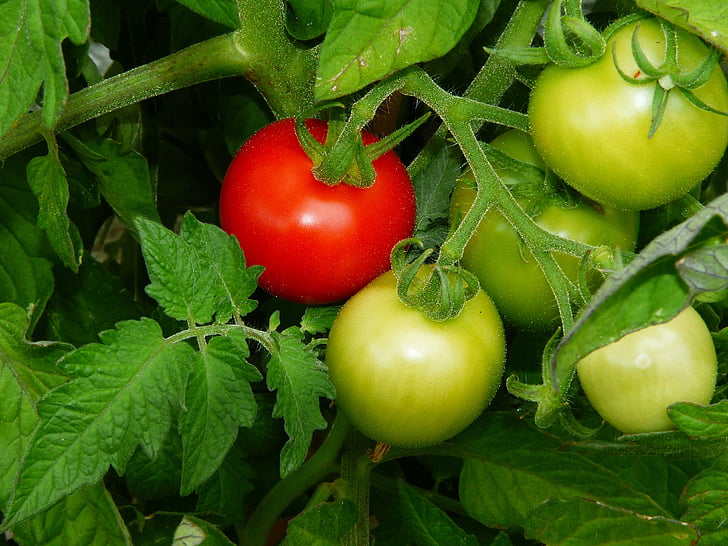Fortunately, learning how to pollinate indoor tomatoes is as easy as 123. Tomato flowers pollinate with the help of the wind and, occasionally, by honeybees. However, if you’re planning to grow tomatoes indoors, factors such as high temperatures and excessive heat can stunt the pollination process.
The Basics of Indoor Tomato Care
For the pollination to work, you need to learn the basics of indoor tomato care. Here are some of the things that you need to remember:

Water your plants regularly
Regularly check your tomato plant’s soil to see if it needs watering. Stick your finger into the soil and if it feels dry, it’s time to water it.
Fertilize the soil each week
Keep your tomatoes healthy and encourage more produce by adding balanced fertilizer. For indoor tomatoes, sea kelp, fish emulsion, or animal manure are all great options.
Help pollinate your plants
Since tomatoes are self-pollinating, they don’t necessarily need gardeners or insects to help them pollinate. But you could speed up the pollination process by placing a small fan to simulate the wind or you could hand-pollinate them.
4 Ways to Pollinate Your Indoor Tomato Plants
Tomato plants are self-pollinating and self-fruitful. In other words, a single tomato plant can produce crops without having to plant another one. But as we’ve already established, you could help hasten the pollination process by hand pollinating them. Here are a few things you can do:
Vibrate your tomato plants using a battery-operated toothbrush
To self-pollinate using a toothbrush, you need to slightly give the vines a little shake by placing the toothbrush at the back of the open flowers. The vibrations will loosen the pollen to encourage pollination.
Place the bristles on the flower stems – not directly on the flowers though! Turn the electric toothbrush on for only a few seconds.
Use an art brush
Aside from a toothbrush, you can use a small art brush to gather and deliver pollen to flowers the same way insects do. The brush doesn’t have to be expensive, but it’s better to use the ones with natural bristles. In this way, the pollen sticks better compared to plastic brushes.
Gently swirl the brush inside the petals, the pistil, and on the stigma to collect and distribute pollen. However, make sure to always use a different brush if you have several types of tomatoes to prevent cross-pollination. If that isn’t possible, dip and dry your brush in isopropyl alcohol before hand-pollinating other varieties.
Use cotton swabs
Cotton swabs are also a great tool for pollination because the cotton can help collect and distribute the pollen. Use the cotton swab similar to how you use an art brush. Another technique is to collect pollen and place them in a small container. You can then use the swab or the brush to manually apply it to the tip of the stigma.
Shake your plants
If you don’t have an electric toothbrush, a brush, or a cotton swab, you can slightly shake the plants to imitate shed pollen. You can gently but speedily tap each flower to encourage pollination.
When Should you Hand Pollinate?
Hand pollination is not a one-time thing. It’s best to hand pollinate every two to three days when the weather is clear.
Target every open flower until the tomato plant stops flowering. In this way, you’re sure that every cluster has been fertilized. Keep an eye out for fruits that begin to form after the flowers wilt.
Why Are Greenhouses a Great Investment for Planting?
Mini greenhouses are great for planting and growing tomatoes and other plants. If you’re still on the fence, here are a few reasons why a greenhouse kit is a sound investment:
Protection from unwanted animals and insect
Aphids, rodents, beetles, and other insects and large animals would love to get a taste of your delicious tomato fruit. Additionally, infectious diseases from neighboring plants can easily infect your garden plants. To keep them safe from unwanted animals, insects, and blight, you can plant then inside mini-greenhouses.
Great for gardeners who need additional space
If you have limited space or if you need more space to grow more crops, you can invest in a small greenhouse. You can place them anywhere – on balconies, decks, patios, or even on your tabletops. Additionally, you can plant almost anything in them and they’re relatively cheap compared to regular-sized greenhouses.
Keep your plants safe from frost
Tomatoes are warm-weather plants, which means they cannot tolerate frost. If you want to grow tomatoes all year round or you want to protect them from unpredictable weather, placing them inside a greenhouse helps. Once the weather warms, you then have the option to transplant them back into your garden.
Final Thoughts on How to Pollinate Indoor Tomatoes
Now that you’re familiar with how to pollinate indoor tomatoes, you’d know that there are different techniques to hand-pollination. Although some gardeners prefer to slightly shake the plants, while others use an art brush, you can use whatever works for you and your tomato plants. For best results, you can hand pollinate every two to three days. You’ll know if the pollination works if the flowers begin to wilt and fruit appears.
